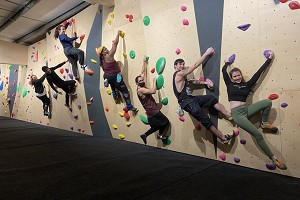
"Are there any gay climbers?" was a question candidly posed as a thread title in our forums in September last year, which sparked an interesting discussion about participation in climbing by gay men - are there any? Where are they? Is there something about our sport which doesn't appeal to gay men? A more recent post enquiring about gay climbing partners in Yorkshire yielded similarly uncertain conjectures and brought up the topic of Lesbian, Gay, Bisexual and Transgender climbing clubs and their role within the climbing community.
Some responses included:
- "Why not join a heterosexual climbing club?"
- "Is this a wind up?"
- "This seems as pointless as a thread seeking fellow ginger haired climbers, or left handed climbers."
- "Surely a common interest in climbing is more important than their sexual interests."
From the above comments it's clear that there is currently little understanding of the situation of LGBT climbers - if we are having to ask whether gay climbers exist, where they are and why they would want to stick together as a minority.
Historically, British mountaineering and climbing has not lacked higher-profile homosexuals. In his 1927 book On High Hills, Geoffrey Winthrop Young - prolific British mountaineer, former Alpine Club President and key figure in the foundation of the British Mountaineering Council - wrote of his motivations for climbing, with an undertone of guilt regarding his then illegal sexual preferences:
"In return for my guardianship of their integrity [the mountains] offered me a sanctuary for all the higher impulses, all the less sordid hopes and imaginings which visited me anywhere through the years."(1)
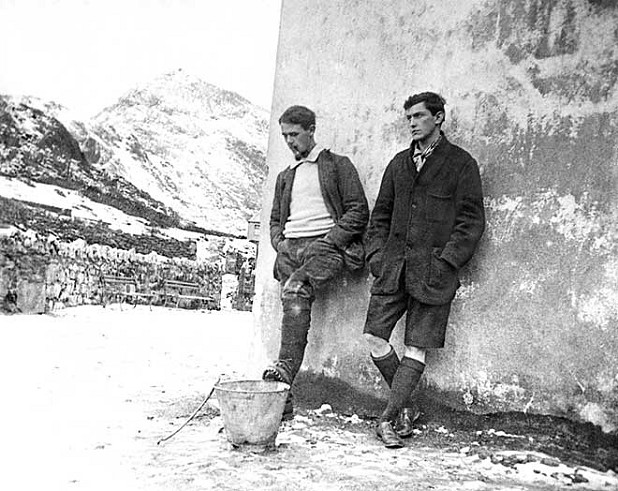
Young was an admirer of Everest mountaineer George Mallory - a member of the 'Bloomsbury set' of Cambridge intellectuals in the early 1900's - who was rarely short of male attention:
"Several of the male members of the group were homosexual and admired George Mallory, as Geoffrey Winthrop Young did, for his exceptional physical beauty." (1)
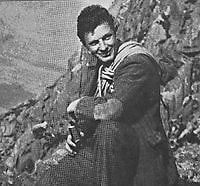
Commenting on the prevalence of homosexuality in this pivotal period in British climbing history, Simon Thompson wrote in his book 'Unjustifiable Risk? The Story of British Climbing' :
"Since most climbers were (not surprisingly) less than forthright about their sexual orientation it is hard to judge how prevalent homosexuality was in climbing circles at this time, but it was probably fairly common. Many leading climbers, both before and after the First World War, went to Cambridge University, where homosexuality was both widespread and generally accepted." (1)
If, at a time when homosexuality was so deeply frowned upon as to be an illegal act, it appeared to be relatively accepted within climbing circles, over 100 years on and 48 years after homosexuality became legalised in the UK, why - in a much more liberated climate - are LGBT climbers relatively under-represented, their voices muted and their choices questioned?
In 2015, it's safe to say that UK society in general is more accepting of homosexuality and transgenderism. Homosexuality is legal, same-sex marriage legislation has been fought for and achieved (with the exception of Northern Ireland), Pride marches unite and better education in schools has created a safer and more tolerant environment for LGBT individuals. Nonetheless, homophobia, transphobia and discrimination still exist and life in a heteronormative society can be a daily battle for many who go against the grain.
As a microcosm of society, climbing attracts people from all walks of life. It's a minority sport for the most part unencumbered by gender groupings, and provides an escape for many into the undiscriminating playground of the outdoors.
LGBT climbing clubs exist, but why do we need them? Is our community unwelcoming to LGBT climbers? There are currently no statistics on LGBT participation in climbing specifically, but on a wider level in sport in general there are patterns emerging which demonstrate the barriers holding LGBT individuals back from taking part in particular types of sport.
This year, Denison and Kitchen conducted a major international study on homophobia and sport. They found that over half (54%) of gay men and over a third (36%) of lesbian women did not feel accepted at all, or only accepted a little, in sport. Smith et al., (2012) conducted a survey of the experiences of LGBT people in sport, of which 115 respondents were transgender (6.7 percent). 75 percent of these respondents thought transphobia was a problem in sport, with 68 percent more likely to participate in sport if it was more transgender-friendly and inclusive to transgender people.
But how do these statistics relate to climbing? To build a bigger picture of the LGBT climbing community in the UK, we got in touch with four individuals who shed light on their situation, what boundaries they come up against and what it means to be an LGBT climber, with some academic insight from PhD researcher in LGBT inclusion in sport Catherine Phipps.
"Sports spaces are symbollically connected to sexuality – as conceived spaces – in genderspecific ways."(2)
Catherine Phipps - PhD Researcher

"Stereotypes exist that gay men are less suited to sport or simply do not participate in high numbers, as gay men are often linked to femininity.
Perceptions that male athletes are masculine/heterosexual may create pressure for gay/bisexual men to keep their sexual orientation private."
However, she maintained that there have been clear improvements and better experiences overall since the 1990s and early 2000s.
Catherine continued:
"For women, the 'lesbian label' still exists, especially for women who participate in traditionally masculine sports, which may pressure lesbian women to hide their sexual orientation or present an image of femininity, especially since female athletes are often heterosexualised in the media. There is very little research on bisexuality and sport; however, research suggests the main barrier for bisexuals specifically is failure to consider bisexuality as a legitimate sexual orientation, and it generally being silenced compared to other sexual orientations."
For transgender people, Catherine revealed that the main barrier in sport is sex-segregation in training/competition; it is often not clear under what conditions transgender people can train and compete in men's/women's teams. This is due to sport often relying on binary models of gender. She explained:
"This causes particular problems for transgender women who compete on women's teams and who are often considered to have a physical advantage over those born female. This is minimised when sports are mixed-gender and non-competitive (such as climbing!). However, indoor climbing facilities with no unisex toilets/single-cubicle changing rooms would still cause issues for many transgender people."
I began to wonder what types of sport are most popular with certain groups, and why - team, individual, recreational or competitive activities all offer different experiences for participants. Could sexual orientation and gender identity shape sports participation?
Catherine commented:
"Research suggests there is a lack of openly gay/bisexual men in mainstream team and contact sports, with a higher likelihood of involvement in health and fitness. This could be due to gay and bisexual men dropping out from these sports in higher numbers, possibly due to bad experiences in school, or other reasons. Alternatively, there may be pressure to 'pass' as heterosexual in these environments, as 'coming out' as homosexual in a hyper-masculine environment may be difficult."
For women, the situation is slightly different, as Catherine described:
"Data from a 2012 study involving 203 lesbian/bisexual women and 230 heterosexual women revealed that women are equally likely to be involved in mainstream club sports regardless of sexuality, although lesbian athletes are slightly more involved in 'masculine' sports. Another study in 2009 stated there are similar participation rates in individual sports and fitness for women irrespective of their sexual orientation. However, an international study on homophobia this year found no significant differences between the types of sports lesbian and heterosexual women were involved in."
The experiences of LGBT students at FE/HE institutions was researched by the NUS (2012) in their report 'Out in Sport'. Catherine explained their finding that traditional notions of gender often informed students' choices around sports participation:
"Individual sports and fitness activities were most popular amongst all groups, but it was found lesbian women were more likely to play organised team sports, and gay and bisexual men were more likely to go to the gym. Gay and bisexual men were underrepresented in mainstream club and 'masculine' team/contact sports, with football especially unpopular with bisexual men. Swimming was least popular with transgender students, the only group to have participation below 5 percent. In contrast, martial arts were found to be more popular for transgender students; it is commonplace for martial arts training to operate in mixed-sex environments."
From Catherine's information, it would appear that social stereotyping can play a significant role in explaining the lower levels of participation in certain sports and activities by LGBT individuals. Climbing could be viewed as a male-dominated sport with hegemonic masculinity playing a key role, despite it rarely being a competitive team sport, with strength and boldness being widely considered as 'masculine traits.' Equally though, it has feminine aspects such as flexibility, grace and gymnastic poise. Does this make it more gender-balanced than other sports perhaps?
Catherine was inclined to agree, but explained that sports are not always easy to categorise:
"Probably climbing would be considered more of a gender-neutral sport than possibly rugby/boxing (masculine) or gymnastics/netball (feminine). However, there are no clear definitions of which sports are considered masculine/feminine/gender-neutral, and this will differ between countries and cultures. For example, football is considered quite a masculine sport in UK, but more gender-neutral in the USA."
Taking gender inequality and the demographic shift within climbing into account, a question arose: as more and more women get into climbing, is this toning down hegemonic masculinity, challenging heteronormativity* and balancing things out? Catherine commented:
"Possibly, and I would argue hegemonic masculinity is probably not as prominent in climbing as it is in gender-segregated sports, which tend to be more hyper-masculine. This was evident in Dashper's 2009 study on equestrianism, another mixed-gender sport."
When asked why heterosexual people might question someone's wish to meet similar people, or even see it as offensive/to the exclusion of heterosexual people when joining an LGBT club, Catherine responded:
"It's hard to know for certain, but from my own research with student unions who run university-based sport, many are against LGBT-only sports clubs as they are not inclusive to all. There is also the perception that people who attend LGBT-only sports clubs are only there to meet a partner, and many find it contradictory that LGBT people would separate themselves, as research on Volleyball in the Netherlands by Elling et al. discovered in 2003."
On the contrary, I wondered why some LGBT individuals might be reluctant to join an LGBT club. Catherine explained that many (not all) LGBT-only sports clubs are based around inclusivity and non-competitiveness, which may deter some LGBT individuals who would prefer competitive sport. Additionally LGBT people who are not open about their sexual orientation/gender identity at all (or possibly only to certain people) may feel uncomfortable attending and publically expressing their identity. She added:
"Some may feel they are effectively excluding themselves from mainstream sport by attending an LGBT-only club – separate LGBT clubs may be marginalised/subordinated. Separate men's and women's teams in LGBT-only clubs would still be an issue for transgender people. Heterosexual transgender people may feel they have little in common with others in LGBT-only clubs."
(*Heteronormativity is a leading principle in most capitalist societies and within mainstream social practices like competitive sports, where especially 'hegemonic masculinity' is celebrated. Heteronormativity refers to the fact that 'real' men and women are considered heterosexual and that according to the 'natural' gender order men possess physical, mental and social power over women.) (2)
To find out more about LGBT climbing clubs, I contacted Not So Trad club founder Martin Oldham to hear about the LGBT climbing community from a club perspective.
Martin Oldham, member of LGBT climbing club Not So Trad
Tell us a bit about Not So Trad!
Not So Trad is a climbing club open to Lesbian, Gay, Bi-Sexual and Transgendered Climbers and Mountaineers, and their friends. The only requirements we ask of members are that they acknowledge the BMC’s participation statement and support the BMC’s equal opportunities policy and equity statement. We are based in London, and most of our members live in London or the South East, but we welcome anyone regardless of where they live. Our full name is “Not So Trad – Southern LGBT Climbers”. Originally we were a group of climbing friends who had formed within the Gay Outdoor Club, but in 2008 we decided to set up independently, because we wanted to have a distinct identity as a climbing club and we wanted to affiliate to the BMC. We also wanted to provide a visible LGBT presence within the UK climbing community, which we felt was lacking at the time.
We now have 110 members. We have a good gender balance, with around 40% women members. This is something we are proud of, because it is rare for LGBT sports clubs to have nearly equal proportions of men and women. I imagine it is fairly unusual amongst climbing clubs too.
We also have members who are transgender or who identify as non-binary gender. One of the things some of our members find appealing about climbing is that it is largely a gender neutral sport – unlike many sports, there aren’t strong gender distinctions in how you do it or who you do it with.
We have a few members who are straight. They joined the club because they are our friends and they enjoy climbing with us. But they also like what we offer as a club. In particular, we have a really varied schedule of climbing meets during the year. It is really affirming that straight people want to join Not So Trad and feel comfortable being part of a predominantly LGBT club. It also shows that Not So Trad is effective and successful as a climbing club. First and foremost, we are a group of climbers – that is what unites us.
Why are clubs such as NOTSOTRAD important for the LGBT community, and for society as a whole?
Not So Trad provides an environment where LGBT people can climb and feel welcome, safe, and uninhibited about being themselves. It’s a place where as a gay man or a lesbian you feel you are normal, rather than the exception. Being in a minority can be quite hard work at times, e.g. if people are making assumptions about us which we need to correct, or we feel we have to challenge stereotypes. For many of us, this is the situation we are in in our working lives, so when it comes to our recreational time we prefer to be in an environment where we are not in the minority and we can be relaxed about who we are. We don’t always want to have to educate or represent, especially after a long day's work! There are a variety of other reasons why people might join Not So Trad: to take up a new activity, to widen their social circle, to meet new people etc, but I think principally it’s about being in a social environment where we feel comfortable and relaxed.
The wider benefit that Not So Trad brings is that it encourages people to take up climbing who might not otherwise do so. LGBT people are under-represented in climbing (and in sport more generally). As a club, we increase the level of LGBT participation in climbing. We do this directly, by welcoming people who are new to climbing and providing opportunities and encouragement for them to develop as climbers (e.g. we hold meets specifically aimed at novice climbers and we organise subsidised ‘learn to lead’ training weekends). Also, by providing a visible LGBT presence in the UK climbing community we can help to challenge preconceptions LGBT people might have about climbing, or climbers might have about LGBT people.
Many members have gone on to climb outside the club and, yes, with straight people! We have members who are also members of the Climbers Club, the Alpine Club, university clubs and a variety of other groups. It’s a mistake for people to think we exclusively climb with LGBT people – this doesn’t reflect the membership of the club, who we are as climbers, or who we climb with. Why are LGBT people under-represented in climbing? That’s hard to answer. I think many LGBT people have the perception, rightly or wrongly, that climbing is a difficult sport to break into, that it has quite a closed culture based around tightly knit social groups, and that you are less likely to be accepted if you are gay, lesbian, bisexual or transgender (I’m not saying this is true, just how it is perceived). The perception that climbing has a ‘macho’ culture can also be off-putting for lots of people, many gay men, and particularly women.
In your opinion, is the climbing community more accepting of minority groups than wider society?
In my experience climbers tend to be more liberal, cosmopolitan and tolerant in outlook than society more generally. As a generalisation, climbers are a friendly and laid back set of people, and more open-minded than most.
I think it’s important to say that there’s a big difference between being accepting of minority groups and being welcoming. Being accessible is not just about leaving the door unlocked, it’s also about opening the door and encouraging people to come in!
What can climbing and the outdoors in general offer people who might feel marginalised from wider society?
Climbing has a distinct feeling of community and its own culture. Being accepted and welcome within the climbing community can give a sense of belonging and shared values, and that can be a very positive thing for people who feel marginalised in other contexts. Learning to climb, developing skills, teamwork, overcoming physical and mental challenges can help build confidence, which can also be valuable for people who feel marginalised.
Does the club experience any form of prejudice or discrimination within climbing circles?
Asking around, I have not heard of any instances of explicit prejudice or discrimination.
A couple of years ago we were climbing at Portland alongside a group from one of the university clubs. Some of them were using the term “gay” to mean something negative, e.g. “you can’t do that move? Don’t be so gay!”. We had a quiet word with them, I think they understood why this was offensive and they stopped doing it. The sad thing about this incident was that it was a university club. University clubs could be playing a valuable role in bringing new people into climbing and encouraging more diverse participation. However, by their behaviour this group was creating a very exclusive environment. If I’d been at that university, there’s no way I would have joined this club, because of their homophobic behaviour. Times change, these sorts of incidents are becoming much rarer thankfully.
What changes have you seen in participation in the club over the last few years? Is awareness growing?
Membership increased rapidly in the first couple years after we set ourselves up, but then levelled off at around 100. We have a steady intake of new members that makes up for people leaving the club. I’d say the average age is falling and we now have a higher proportion of members under 30 than we did a few years ago. We don’t have many inactive members. Meet attendance has increased year on year, and become more consistent, because we have got better at organising the meet schedule and working out what members want. Some meets, particularly those aimed at novices, can have over 30 attendees. Most have between 10 and 20 attendees. We have a regular indoor climbing night every Wednesday at the Castle in North London, which gets 20+ people each week.
We now have more members who live outside London. Partly this is because members have moved away for work, but stayed in the club. But it’s also because new members who don’t live in the South East are joining, which reflects a greater awareness of the club outside London. We don’t have aspirations to be a UK-wide club, because organising a national membership and meets schedule would be too much of an administrative burden. We are more interested in climbing than committee meetings etc. But we’d be happy to consider partnerships or collaborations with other groups and clubs, e.g. by having joint meets.
Have attitudes towards the club from non-LGBT climbers changed at all?
I think more people have heard of us. We often get chatting to other climbers in campsites, in huts, on belay ledges etc, and typically they ask who we are and where we are from. Reactions are overwhelmingly positive. It was nice to see someone recommending us in a post on UKC recently: “Not So Trad is a really good gang and very active and I would highly recommend seeking them out, even if you’re straight (can I say that?)”
Why do you think people would question an individual's wish to meet similar people, or even see it as offensive/to the exclusion of heterosexual people?
This comes up from time to time. Someone once posted on UKC that we were discriminating against him because he was straight. So we invited him along to one of our meets to climb with us. And he said he thought we were a friendlier bunch than many of the other climbing clubs he knew!
We are not exclusive – we have straight members and many of us have straight climbing partners outside the club. This year we organised joint meets with the Climbers Club and the Pinnacle Club, and that’s an initiative we hope to develop further and with other clubs. If anyone wants to climb with us, get in touch and we’ll see what we can sort out. We are happy to extend the hand of friendship to anyone who wants to climb with us.
What is your response to someone who claims that sexual orientation and gender identity shouldn't make a difference in climbing partnerships, and asks why you don't want to join a mainstream club?
Often statements like this come from people who don’t really understand what it’s like to be lesbian or gay in an environment where the majority of people are straight. Behind it there’s an assumption that because there is less direct discrimination these days, LGBT people should be happy joining in with everyone else. But being equal doesn’t mean being the same. As I explained above, for many of us, being in Not So Trad is about being in an environment where you feel, in terms of your sexuality, you are the norm rather than the exception.
It is a false dichotomy to present it in terms of “LGBT” and “non-LGBT”. We don’t see Not So Trad as an alternative to the rest of the UK climbing community – we aim to be a club that adds something to the climbing community, by providing a specifically LGBT-friendly climbing environment that doesn’t exist elsewhere.
However, there is a legitimate criticism that by segregating ourselves in our own club, there are fewer LGBT climbers dispersed among other clubs, which means members of those clubs are less aware of LGBT climbers, and there is less being done to combat homophobia and trans-phobia or to challenge stereotypes in those contexts. This is undoubtedly true (and a problem in LGBT sport more generally, and particularly team sports). But attitudes around LGBT inclusion have shifted a great deal, even in the past 7 years since we set up Not So Trad. LGBT people are gaining more confidence about moving into environments they have previously felt excluded from. We would hope that over time it becomes more normal for mainstream climbing clubs to have LGBT members.
What do you think could be done to create a more welcoming environment in climbing walls and mainstream clubs?
· Climbing walls and mainstream clubs should adopt and enforce a zero tolerance policy towards homophobia and transphobia.
· Clubs should think about diversity, how they can be more inclusive and more open to LGBT people. Talk to LGBT people about it!
· Clubs could actively promote themselves as inclusive and LGBT-friendly. University clubs, which have a duty to be inclusive, should definitely be doing this.
· Collaborations (e.g. joint meets) with LGBT groups like Not So Trad.
From Catherine's statistics on LGBT sports participation and Martin's mention of the perceived 'macho culture' in climbing - I wanted to find out why fewer women join LGBT clubs than men and why. To find out more from a female perspective, I contacted lesbian climber Roslyn McKendry.
Roslyn McKendry, biology lecturer, founding member and ex-president of Not So Trad
Why do you think so few LGBT individuals might be attracted to climbing as a hobby/sport? Are there invisible barriers?
I generally meet very few LGBT people anywhere, unless I go out of my way. When I returned to the UK, I started climbing at the Castle in London and met a good group of friends there. I also linked up with some LGBT climbers – I don’t remember how I did this but I definitely had to go out of my way to seek them out. We ended up founding Not So Trad, so now I actually know lots of LGBT climbers but I guess this is not the norm.
In your experience, are people more or less welcoming in the climbing world than in your other activity groups, or than society as a whole?
In general I find climbers to be a great bunch and have rarely experienced anything negative.
Have you experienced prejudice or discrimination within climbing circles?
One incident that comes to mind was a negative reaction to Not So Trad being an LGBT club.
Why do you think people would question your wish to meet similar people, or even see it as offensive/to the exclusion of heterosexual people?
I guess there could be a number of reasons for this. Some people might assume that an LGBT club is exclusive (which NST is not – we have quite a few straight members), that it has a big ‘Keep Out’ sign posted over it, and react to that ... or they may take our interest in meeting together as some sort of criticism of the straight climbing community.
I had two reasons for joining an LGBT club. On moving to London I hadn’t intended to make any special effort to meet LGBT people. I assumed that this would happen naturally, and that over time I’d make some LGBT friends. After 3 years I really had not met anyone! I think if you ask a straight person to imagine living in a world where they are surrounded by LGBT people and never meet straight people, most (all?) would concede that they would be pretty keen to meet others like them. That was my first reason. I just wanted to meet people like me and, if we had a shared interest in rock-climbing, even better. Secondly, even if straight people are open and welcoming, LGBT people can sometimes feel uncomfortably different. This happens to me when I am home in Ireland. Everyone else I know there got married in their 20s, got a mortgage, has two kids, a stable job etc. I can still sometimes feel a bit like a freak.
Why do you think there are generally far fewer women than men joining LGBT clubs? Does the "macho" element in sport play a role in this?
There is generally a male/female imbalance in LGBT clubs, and sometimes a really big one. I expect there are various reasons for this.
Language plays an interesting role. Back in the 70s, many LGBT clubs used to be called ‘gay’ clubs, but a lot of lesbians didn’t feel included in the term ‘gay’ and the clubs were predominantly male. Gradually clubs started including ‘lesbian and gay’ in their name. Not So Trad actually evolved from the Gay Outdoors Club which was predominantly male – perhaps 20:1 (male:female) at a guess. We made sure to include ‘lesbian and gay’ in our strapline and members were committed to creating an inclusive environment. But it took a long time to see that intention translate into a more diverse membership. When a potential new female member shows up and sees 15 male members and one female member some will question whether this really is the club for them. We had a hump to get over. And we needed to think about all the ‘messages’ sent out by the group, not just in words, but also photos used on the website, flyers etc. Did they reflect the diversity we wanted to represent?
I’m sure there are many other reasons for low female participation in LGBT clubs. Men have historically been encouraged more in sports, may be more confident, volunteer more readily to get involved. These are obviously generalisations, but I think they play a role. And then, of course, not everyone sees lesbians and gay men as the most obvious grouping. Although many of us have shared the experience of feeling alienated or marginalized due to our sexuality, we are men who form primary relationships with men, and women who form primary relationships with women. Someone once described it as being like a restaurant that serves vegans and cannibals!
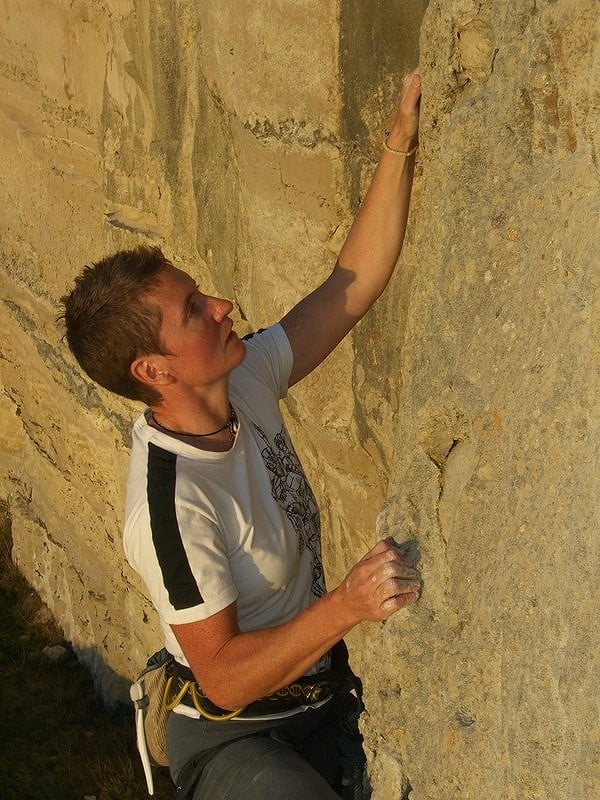
Going back to the language point, more recently (perhaps 2 years ago) NST decided to change the words in our strapline. Although bisexuals and transgender people were included in out constitution they weren’t mentioned upfront in our strapline. We changed ‘lesbian and gay’ in the strapline to ‘LGBT’. Many lesbians and gay men haven't been very accepting of bisexuals or transgender people historically. This is much better now. Just because we're a bit different doesn't mean we are always good at negotiating other types of difference. But we're learning. I actually think NST does a really good job of being inclusive. Having some straight friends and transgender members, joining and taking up posts in the club, felt like a really positive step. It is relatively easy to feel comfortable with others who have a similar experience of the world as you (not just a comment about LGBT people!) but so much richer if you can break out of that. The partnerships forged through epic days of climbing really help to break down barriers between people. I think most of us would say that our social circle is more diverse since joining NST…and richer for it.
How easy or hard is it to find other LGBT climbers to climb with?
It’s very easy for me in London as I live right next to the wall where Not So Trad meet. I’m guessing it's not so easy elsewhere. I’m really not sure how many LGBT climbing groups there are out there.
What is your response to someone who claims that sexual identity and gender shouldn't make a difference in climbing partnerships, and asks why you don't want to join a non-LGBT club?
For me it generally doesn’t matter whether my climbing partner is LGBT or not and probably at least half of my climbing partners are not. I am also in a non-LGBT club, the Climbers Club. However, it is really nice to be part of an LGBT group too. We have some similar experiences of the world and it is nice to have those experiences easily understood. Plus we must have a great meets list!
Dax Hawkins started the thread in the forums looking for other gay male climbers, and was met with a response which surprised him. I contacted Dax to hear more from his point of view as a homosexual male.
Mark 'Dax' Hawkins, 32, IT Manager, Yorkshire
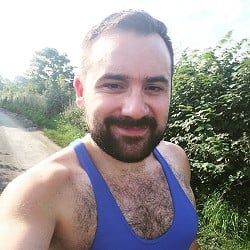
How did you discover climbing?
My Dad was a climber from a young age and as me and my brother were growing up he took us with him and his friends. I don't ever remember a conversation asking if we wanted to go, we just did. Alternatively being age 10/11ish, I might have just gone because everything my older brother did, I wanted to do also.
Did you have any preconceived ideas about what the climbing community might be like before you got into it?
As a young boy my perception of the community was one of a male dominated macho one. Without realising at the time this was appealing to me, way more than playing or watching football.
How did the reality match up?
It certainly felt intimidating at first, but as I became comfortable 'being a young lad at the time' there was just an acceptance from all other around either at the indoor walls or outdoors. Being gay and a climber wasn't really a issue until I was much older, even then the only part that was the issue was being gay and coming to terms with that. Being an outdoor action adventure kind of guy was just who I was and somehow I had to mix the two sides of me together, this is still a 20 year work in progress.
As a 30 something man now, I still feel some bravado behind the sport yet now much more inclusive.
Do you take part in other hobbies which have a larger (or smaller perhaps) concentration of LGBT people? if so, what are they?
I have a large circle of LGBT friends but I don't feel I have any one particular hobby in common with any of them apart from going to the gym. I wouldn't identify myself as a stereotypical gay man or climber, more of an anomaly in the status-quo. Another hobby of mine is Kayaking which seems to have many similarities to my situation with climbing aswell.
Why do you think so few LGBT individuals might be attracted to climbing as a hobby/sport? Are there invisible barriers?
Stereotypes are everywhere whether we like it or not, (I hate to say this) unfortunately LGBT individuals don't necessarily fall into the climber stereotype 'that often'. This is a great shame because its a fantastic sport, more might enjoy if given the opportunely (e.g. life or friends or parietal interest) aswell as their preconceptions of ridicule and discrimination being dispersed. Fear of heights would be the only other barrier the general population could face.
In your experience, are people more or less welcoming in the climbing world than in your other activity groups, or than society as a whole?
My perception of acceptance is; 'If you can Belay and aren't a cretin' then your welcome which is a nice philosophy for the climbing community to adopt, and because climbing is a risk-full skill shared there is a respect for all personal levels this is not necessarily transferred to other activities or society.
Have you experienced prejudice or discrimination within climbing circles?
Despite some peoples narrow-minded view ive always felt welcomed into the climbing community, Its life in general that seems to be saturated by homophobia, especially perceptions of masculinity (or lack of) depending on various situations.
How easy or hard is it to find other LGBT climbers to climb with? Are you aware of many clubs or gay climbers in your local community?
I would have to say LGBT climbers are few and far between, defiantly a minority within a minority which is a disappointing situation to be in. I'm not naive to think I'm the only gay in the climbing wall (I know I'm not) but when its not a common occurrence it does feel a little emotionally isolating, even when surrounded by great climbing friends.
There are some great clubs that have established members and great reputations but these seems to be Big City clubs (obviously near the highest concentrations of the minorities).
Why do you think people would question your wish to meet similar people, or even see it as offensive/to the exclusion of heterosexual people?
People have and will continue to question my motives and curiosity to find other Gay climbers simply because they don't understand. When you are a majority why do you need to care about a minority? Someone has leaped to my defence on this very subject with their heatworming reply to my forum post; 'Being gay, and being a climber are both important parts of my life. It would be nice to meet more people who occupy that small part of the Venn diagram.'
What is your response to someone who claims that sexual identity and gender shouldn't make a difference in climbing partnerships, and asks why you don't want to join a mainstream climbing club?
In most respects is shouldn't, being gay or straight doesn't make you a better climber or person in either way nor should gender have any impact. But free choice is everyones privilege, if I want to seek out others like me why is that any concern of anyone who doesn't agree? It doesn't impact them in the slightest. I have no abjection to joining a non-LGBT group but if I seek a group that is more likely have have a similar outlook on life as me, I am potentially going to have more in common with that group. No one should feel the need to question that.
"Compared to the relatively small sexual differences in terms of frequency of sports participation, sport participants’ choices for specific organizational contexts and kinds of sports seem to be more poignantly influenced by sexual identity, especially among men." (2)
Even less well-represented in the climbing world are transgender individuals. I got in touch with Glasgow-based climber Mathew Wilkie who was keen to shed more light on transgender issues.
Mathew Wilkie, 24, PhD student - Pansexual (Bisexual) transgender man
"I've been on UKC for 10 years now – When I first posted about anything transgender (a post a few years ago about transgender day of remembrance) the overwhelming response was 'what are you talking about. Go away'. There were a few trolls, some people who vehemently argued that they would never climb with a transgender person because they are abominations, a good few who had no problem with trans people at all, and a few people who thanked me for posting. I know it's not representative of the community really, but the reaction has improved slowly and steadily. There are few people that are genuinely outspokenly homophobic on here now, but a lot of people took a long time to come round. Now there are just more nuanced problems – like not understanding why an LGBT person might want to climb with other LGBT people, and what the frig non binary people are and why you should respect them. But these are still things that take their toll on LGBT people."
Why do you think so few LGBT individuals might be attracted to climbing as a hobby/sport? Are there invisible barriers?
LGBT people are less likely to go climbing for a few reasons:
It's seen as macho by outsiders, and with macho environments comes the idea that people maybe homo/trans/bi phobic. It is a cis/white/straight male run sport. Transgender people may not feel comfortable in revealing clothes, or be able to change in public spaces, and may have different body types and needs to cisgender people. Trans men wear chest compression vests which are hard to do sport in so can't really be used to walk up big hills. Going for a day out, or to the wall, may be fine – but going away for weekends with a student climbing club may put a trans person at risk of being 'outed' as trans and there is a risk that people may be hostile towards you. In addition, compression vests or other trans-specific clothing would then have to be worn for the entire weekend (if sharing a tent or dorm with someone) which is dangerous and painful. Also, it's often hard to persuade a pal to come with you and it may bescary going on your own.
As climbers come from all different backgrounds there will be some people who say things like 'that's so gay, don't be such a girl, you're too manly/butch to be a woman' etc which are painful to LGBT people but can't be avoided. Climbing is, and has always been, very cis and hetero normative. It's assumed you are cis and straight, which is frequently evident – creating an atmosphere of oppression, even if it is not active oppression. There are never any gender neutral changing or toilet facilities at climbing walls which are sometimes necessary for trans people. There are no high-level out LGBT climbers, so there are no role models.
Does social stereotyping or gravitation towards larger, more stereotyped LGBT groups in areas such as the arts perhaps play a larger role in explaining the lower levels of participation in outdoor activities?
It plays a role for sure. If there are more role models, the other participants are less likely to discriminate against you and your friends are more likely to be involved with them so you are more likely to find a place to start and have more fun.
As more women get into climbing, is this toning down the hegemonic masculinity, challenging heteronormativity and balancing things out?
Certainly – it started off being a pretty much entirely male sport. With more women getting involved there is a liberalising of the attitudes around climbing, proving that other people can climb, which leads to trans and gender nonconforming people being able to do so – this is the case with all initially male-dominated things throughout history. It also means LGBT people are more likely to get involved, for the same reasons.
More women getting involved in climbing is fundamental to more LGBT people being able to get involved.
Climbing is likely to be viewed by many as an individual activity, yet it can also be very social and practised in large groups. Do you agree that sexual identity has influenced your choice of activities, and perhaps the ways in which you take part in climbing ?
Yes. I stopped climbing in a big club because it was disheartening and painful to hear sexuality and gender based slurs that were thrown about non-stop. I more often go out with a small group of people now, and mostly with people I know are LGBT or LGBT friendly and know about my gender and sexuality.
In your experience, are people more or less welcoming in the climbing world than in your other activity groups, or than society as a whole? Have attitudes towards LGBT climbers changed at all?
Probably more welcoming than society. You are all climbers, and mostly climbers just want to climb. So as long as you can belay and walk up a hill you're set.
But, also you get the downsides in large groups that you don't have much of a choice in climbing partners, because you ignore peoples opinions for the climbing. So you are more likely to hang out with someone who is prejudiced.
Mostly I live my life around people who are not at all prejudiced – like most people I have a social circle comprising people who I get on with and respect. However with climbing in big groups you don't just have your social circle, so it may be less welcoming than the other circles you choose to hang out in – but more welcoming than society in general.
Have you experienced prejudice or discrimination within climbing circles?
Yes. Mostly verbal harassment or people not understanding that there may be bisexual or transgender people around them.
You sometimes get transphobia because people thinks it's funny to put a guy in a dress, or laugh at gender nonconforming people calling them 'heshes' etc. It's not. This is transphobia.
How easy or hard is it to find other LGBT climbers to climb with, particularly Transgender climbers? Are you aware of many clubs or LGBT climbers in your local community?
The Venn Diagram does not have much of an overlap. I usually start in LGBT circles, and ask if anyone climbs. This means usually that you are always the experienced one as you often spend a lot of time taking people who are interested but don't have any experience – because at least you have someone to go with.
Also, not many people you might meet at walls etc will mention they are LGBT to you – why would they?
Trans climbers – I've met close to none. A few that boulder occasionally, but only a few that are actual climbers. I've now got a trans climbing partner (who is also my /partner/ partner) but again before we met he hadn't been climbing in years and didn't do anything except bouldering.
I'm not aware of any LGBT clubs, but I am starting a trans (and potentially LGBT in general) bouldering club in the near future.
Why do you think people would question your wish to meet similar people, or even see it as offensive/to the exclusion of heterosexual people?
When people are surrounded by other people just like them they do not realise how draining it is to be different. Even if they are not at all prejudiced, there is something very relieving about being in a space with people that you know will understand you. Unless you are a minority, or you see the microagressions experienced by minority people you care about, you will not realise the need to be around similar people. Therefore, these people will not see the desire for LGBT people to hang out with similar people, and will dismiss these needs as silly.
In addition, people who do not face violence and discrimination may not realise how much more of a risk it is for an LGBT person to meet up with someone/some people they have not met before to go climbing. There is always the risk that these people will be prejudiced towards LGBT people. Even if not actively so, they may have stereotypes in their head, or use words like 'gay' pejoratively and things – all of which aren't pleasant to LGBT people. So non-LGBT people may say 'why are you worried about meeting non LGBT people? They will not harm you!' not knowing the actual risk, or fear of risk, that is present. It’s not a matter of not wanting to hang out with non LGBT people - 'heterophobia' doesn't exist.
This risk is increased a lot for transgender people. As a person that has not gone 6 months over the past 4 years without being attacked in the street specifically for being transgender I am sometimes nervous meeting people that may not be ok with it. It is hard to understand the fear that goes with the constant threat of attack if you do not experience it. Therefore people will again dismiss these risks as negligible. My own family say that I am too worried about attack and that I am making a big deal where there's no real risk. But trans people are still murdered and assaulted and sacked and made homeless and denied medical treatment for being trans – people just don't want to think that it is a risk.
Basically what people are saying is '"Do you think you're special? I don't think you are any different from anyone else – so stop pretending to be.'' Which is great! Maybe those people aren't homo/trans phobic! But a lot of people are. If we think back we can draw similarities with the debates over womens' spaces, where men/masculine people could not comprehend the need for women only spaces because they themselves were not an aggressor.
For people who are neither men nor women – non binary people – their risk of rejection is higher. People who use gender neutral pronouns (they/them, not he or she) are at risk of their gender not being accepted. Very few people understand that other people can be nonbinary – binary gender is ingrained throughout society – so why would such a person not choose to have their gender respected if they could?
LGBT Climbing Clubs
References and Further Reading
- Elling, Agnes and Jan Janssens: '"SEXUALITY AS A STRUCTURAL PRINCIPLE IN SPORT PARTICIPATION: Negotiating Sports Spaces," International Review for the Sociology of Sport , March 2009, vol. 44 no. 1 (71-86)
- Thompson, Simon: Unjustifiable Risk? The Story of British Climbing, Cicerone Press, 2010
- National Union of Students 'Out in Sport' Study Report
More Articles



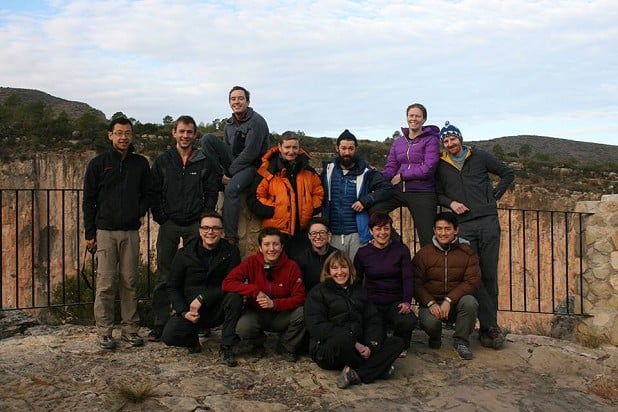
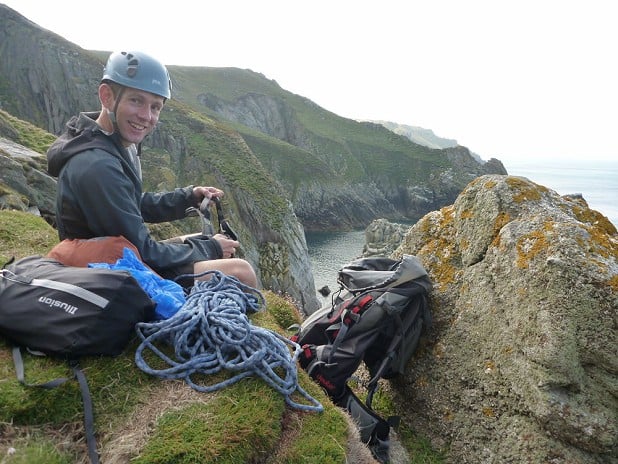
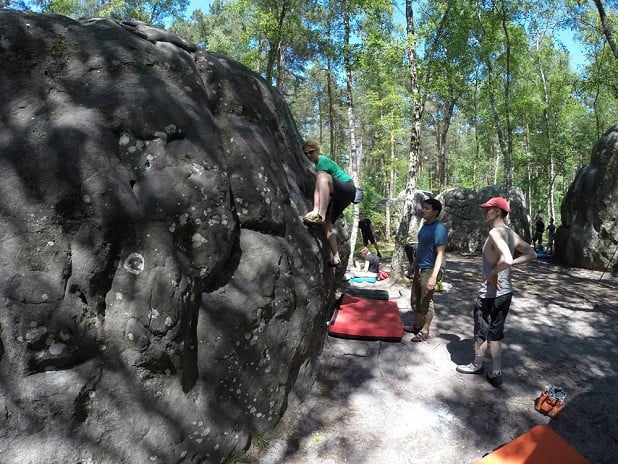
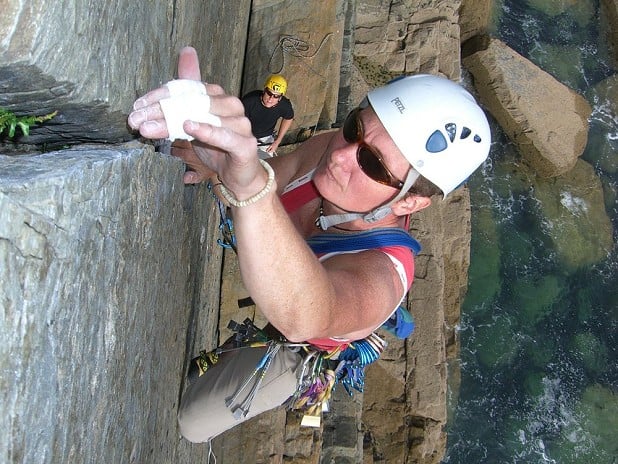
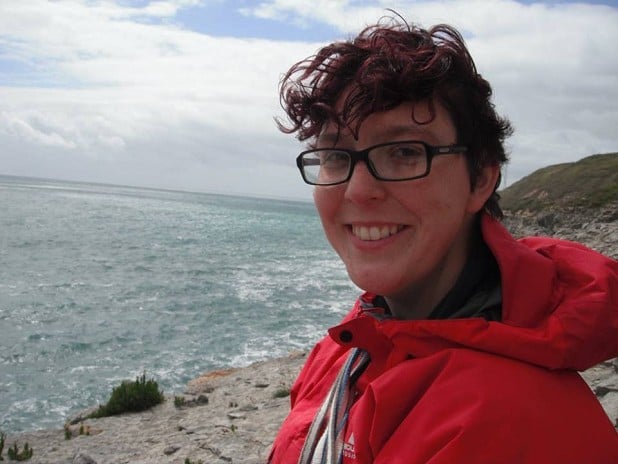
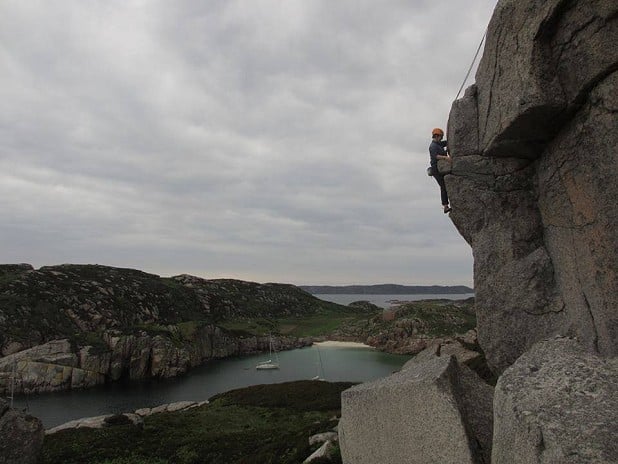

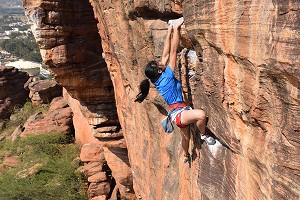

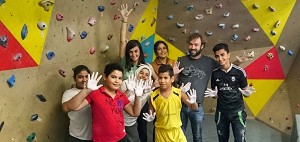









Comments